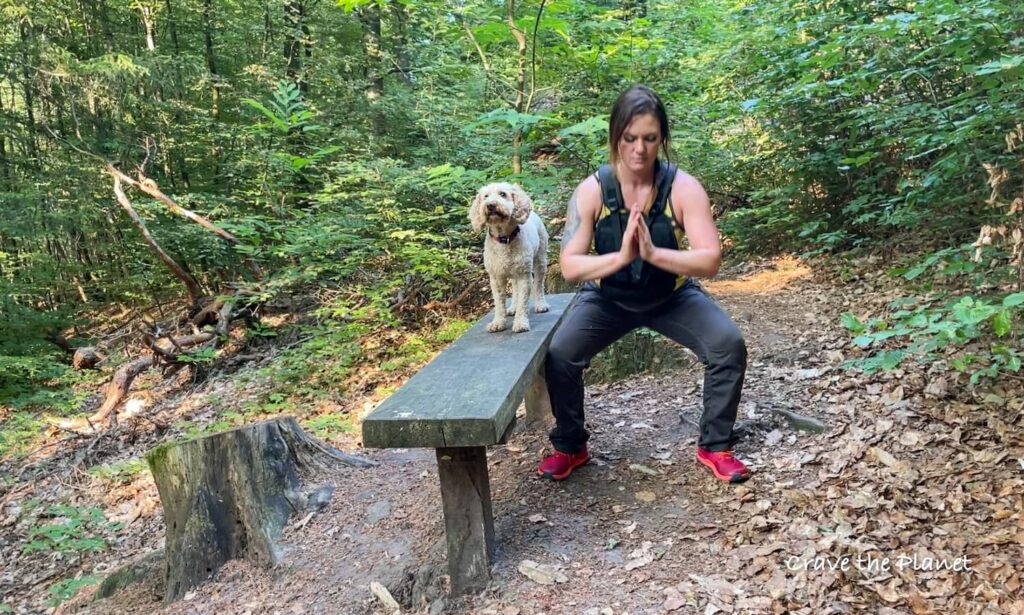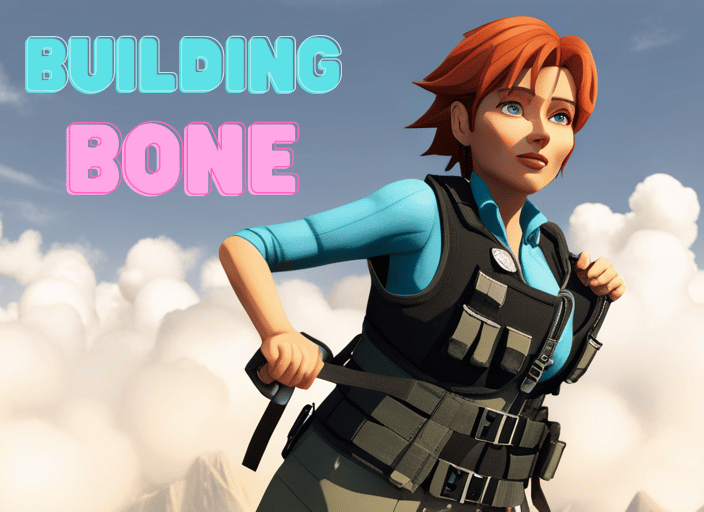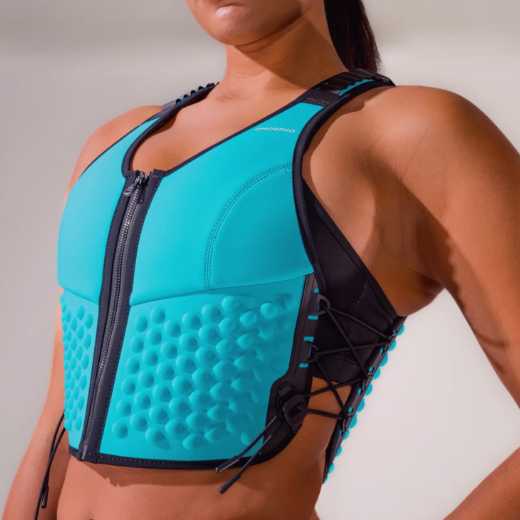
Are you at risk for bone density problems and curious about weight vests for osteoporosis prevention?
As a physical therapist with 17 years of experience, I can guarantee you that building strength and bone health are essential to your quality of life. I’ve worked with women in nursing homes up to the age of 102 and frailty is something you absolutely want to avoid if possible.
It’s about dignity and freedom and that starts with our body and mind and strong bones are the scaffolding of mobility.
But not every woman wants to join the local crossfit gym or hang around with sweaty boys at the gym (or maybe we do!).
Enter: Weight Vests for Osteoporosis Prevention.
It’s like a gym you can take anywhere with just a set of hiking boots and a ladies weighted vest.
What You Will Learn
- Quick Verdict: Top Pick Best Weight Vest for Osteoporosis
- What is the Purpose of Wearing Weight Vests for Osteoporosis?
- Who Should Not Wear a Weighted Vest?
- Research Supporting the Use of Weighted Vests
- What Should the Weighted Vest Look Like?
- How Much Weight Should You Put in Your Vest?
- How Long Should You Wear the Vest?
- Alternative to Weight Vest for Osteoporosis
- Final Verdict
- FAQ
Quick Verdict: Top Pick Best Weight Vest for Osteoporosis
What we like: The vest is made of high-quality materials that are designed to last. The outer layer is made of durable nylon, while the inner lining is made of breathable mesh that helps keep you cool and comfortable during even the most intense workouts.
- Pros: Bluetooth link, microload, stylish
- Cons: Max at 4 lbs, pricey
Note: This high quality vest is made to be form-fitting.
If you’re in search of a versatile weighted vest that can keep up with all your training needs, check out the Omorpho G – Vest+.
You can find it at Omorpho. This microload vest feels snug and didn’t bounce while doing some strength training and hiking on big hills. You can do anything with it on and you forget it’s there as it’s really nice and form fitting.
Key Takeaways
- Weighted vests can be an effective tool to improve bone density and quality, but it is important to consult with your care team before use.
- Research studies have shown that using a weighted vest during exercise can help maintain or improve bone mineral density.
- When using a weighted vest, it is recommended to start with a lighter weight and gradually increase as tolerated, and to use it during specific exercises or activities under the guidance of a professional.

What is the Purpose of Wearing Weight Vests for Osteoporosis?
The main purpose of wearing a weighted vest is to add more stress, the good kind of stress, to your bones which can help increase bone density and quality over time. This concept is based on Wolf’s Law, which states that bones respond to the stress we place upon them.
This is why resistance training is vital for women of all ages.
By wearing a weighted vest, you can provide your bones with the necessary stress to stimulate bone growth without a gym.
However, it is important to note that not everyone should wear a weighted vest. If you have severe osteoporosis or have recently had a vertebral fracture, it may not be the best tool for you.
It is important to consult with your care team to determine if it is safe for you to use a weighted vest.
Several studies have shown that a weighted vest can be an effective tool in improving bone mineral density. However, it is not a magic solution and should be used in conjunction with other exercises and interventions.
It is recommended to start with a weight of 5-10% of your body weight and to be very directed about the exercises you do while wearing the vest.
Adding impact training to a weighted vest can also exponentially improve your gains from a bone mineral density perspective, but it is important to work with a trainer initially to ensure proper form and prevent injury.
Who Should Not Wear a Weighted Vest?
While a weighted vest can be an effective tool for building bone density, not everyone should wear one. If you have severe osteoporosis or have recently had a vertebral fracture, it may not be the best tool for you. It’s important to consult with your care team to determine if it’s safe for you to use a weighted vest.
Additionally, if you have an increased risk of falls or balance issues, a weighted vest may not be the best option for you. It’s important to consider the potential risks and benefits before incorporating a weighted vest into your exercise routine.
It’s also important to note that a weighted vest should not be the only tool you use to improve your bone health. It should be used in conjunction with other exercises and strategies for building bone density.
It’s important to consult with your care team and consider your individual situation before incorporating a weighted vest into your exercise routine. While it can be an effective tool for building bone density, it may not be suitable for everyone.
Research Supporting the Use of Weighted Vests
If you are looking for ways to build bone density and improve bone health, you may have come across the idea of using a weighted vest.
While there is literature that supports the use of a weighted vest, it is important to understand the difference and when it is safe and appropriate to wear one. In this section, we will go through some of the research that supports the use of a weighted vest.
The Erlanger Fitness Osteoporosis Study
This study was published in 2004 and lasted for over two years, making it a long trial for fitness and exercise. The study used a weighted vest in the intervention and had a control group.
The outcomes were positive, with the patients in the intervention trial maintaining or improving their bone mineral density.
However, the study did not have a third arm that just did exercise without the weighted vest, making it difficult to determine if the weighted vest was the intervention that made the difference.

2016 and 2017 Studies
Two newer studies conducted in 2016 and 2017 also used a control group that did not do exercise and had relatively long interventions that included different forms of exercise with the weighted vest. Both studies showed improvement compared to the control group, but again, there was no study arm that just did exercise.
2012 Study with Three Arms
This study had a control group, an intervention group with a weighted vest, and an intervention group without a weighted vest. The participants exercised for 30 minutes three days a week, mainly walking with the weighted vest.
The study concluded that there was no statistically significant difference between the weighted vest group and the exercise group, but both groups did better than the control group.
However, the weighted vest group had more improvement in balance and motor control, which is important for preventing falls.
Additionally, the study showed a trend towards significance in the weighted vest group versus the non-weighted vest exercise group in terms of bone turnover markers.
The research suggests that a weighted vest can be an effective tool to improve bone health, but it is not a magic bullet and should not be used by everyone.
It is important to consult with your care team and start with a lighter weight, potentially 5-10% of your body weight. Additionally, it is crucial to be very directed about what you are doing and avoid getting into awkward positions with extra weight on your spine.
What Should the Weighted Vest Look Like?
When it comes to selecting a weighted vest, there are a variety of options available on the market. The most common type of weighted vest is similar to a vest that you would wear on a cold day, but with added weight.
These vests typically have separate plates that can be inserted into pockets on the front and back of the vest, allowing you to adjust the weight as needed.

The weight of the vest will depend on your unique situation, and it’s important to start with a weight that is safe for you.
In general, unless you have severe osteoporosis or have recently had a vertebral fracture, it’s safe to start with 5-10% of your body weight. However, it’s important to consult with your care team before starting to use a weighted vest.
When it comes to wearing the vest, it’s important to be very directed about what you’re doing. You should only wear the vest during specific exercises or activities, such as going for a walk or doing squats and lunges.
It’s not recommended to wear the vest for prolonged periods of time, as this can increase your risk of injury.
Start with a weight that is safe for you, and be very directed about when and how you wear the vest. If you’re looking to add impact training, work with a trainer initially to ensure that you’re doing it safely.
How Much Weight Should You Put in Your Vest?
When it comes to how much weight you should put in your vest, it depends on your unique situation.
Generally, it is safe to start with 5% to 10% of your body weight.
However, it is important to note that 10% of your body weight is still a significant amount of weight to move around, especially if you plan to wear the vest for a prolonged period of time.
It is also important to consider your individual health conditions.
If you have severe osteoporosis or have had a recent vertebral fracture, it may not be safe to wear a weighted vest.
In these cases, it is best to consult with your healthcare provider before using a weighted vest.

The weight plates for your vest usually come separately from the vest itself and can be as light as one or two pounds.
The weight plates can also be added or removed, so you can adjust the weight according to your needs and comfort level.
If you plan to wear the vest for exercise, it is recommended to wear it only during the duration of the exercise.
However, some studies have shown that wearing the vest for a longer period throughout the day, such as four to six hours, can also be effective. It is important to be cautious and avoid getting into awkward positions with extra weight on your spine, which can increase the risk of injury.
How Long Should You Wear the Vest?
When it comes to wearing a weighted vest, the duration of use is an important factor to consider. In general, the participants in the studies wore the vest only for the duration of the exercise.
However, there are other studies where participants wore the vest for several hours throughout the day to do activities of daily living.
It’s important to listen to your body and not push yourself too hard. If you experience any pain or discomfort, it’s important to stop and take a break.
Gradually increasing the duration of use over time can help you build up your tolerance and avoid injury.
Alternative to Weight Vest for Osteoporosis
If a weighted vest isn’t the right tool for you, there are other options to consider. Here are a few alternatives to a weighted vest:
- Resistance Bands: Resistance bands are a great alternative to a weighted vest. They are lightweight, portable, and can be used for a variety of exercises. Resistance bands come in different strengths, so you can increase the resistance as you get stronger.
- Bodyweight Exercises: Bodyweight exercises are a great way to build strength and improve bone density. They don’t require any equipment and can be done anywhere. Examples of bodyweight exercises include push-ups, squats, lunges, and planks.
- Dumbbells: Dumbbells are another great alternative to a weighted vest. They come in different weights, so you can start with a lighter weight and gradually increase as you get stronger. Dumbbells can be used for a variety of exercises, including bicep curls, shoulder presses, and lunges.
- Yoga: Yoga is low-impact exercise that can help improve bone density. It focuses on flexiblity, balance and strength. Poses like downward dog, warrior II and tree pose can help build strength and balance.
Remember, it’s important to talk to your doctor before starting any new exercise program. They can help you determine which exercises are safe and appropriate for you.
Final Verdict
In conclusion, the use of weighted vests can be an effective tool for improving bone health and density, but it is not a magic pill that can solve all your bone health problems.
The research shows that wearing a weighted vest adds stress to your bones, which in theory can increase bone density and quality over time. However, not everyone should wear a weighted vest, especially those with severe osteoporosis or recent vertebral fractures.
Several studies have shown that wearing a weighted vest during exercise can maintain or improve bone mineral density compared to those who do not exercise at all. However, there is no clear evidence that the weighted vest alone is the intervention that made the difference.
The exercise alone studies showed better improvement than the studies that used a weighted vest.
Related Resources
MORE WEIGHT VEST RESOURCES
Get more physical therapist expert tips here 👎🏻
- Hiking with a Weighted Vest Safely
- Enjoy Hiking as a Hobby
- Weighted Vest Walking Benefits
- 🥾 Best Hut to Hut Hikes in Europe
- How to use a weighted vest to lose weight
- 🏰 Directory of Hiking Resources to Make Your Next Hike Comfortable
FAQ
Can anyone wear a weighted vest for bone health?
Not everyone should wear a weighted vest for bone health. If you have severe osteoporosis or have recently had a vertebral fracture, it may not be the best tool for you. It’s important to consult with your care team to determine if it’s safe for you to wear a weighted vest.
How much weight should I put in my vest?
The amount of weight you should put in your vest will vary based on your unique situation. It’s recommended to start with 5-10% of your body weight, but again, it depends on your individual scenario. It’s important to be cautious and not add too much weight too quickly.
How long should I wear the vest?
In the studies discussed, participants only wore the vest for the duration of the exercise. However, there are other studies where participants wore the vest for several hours throughout the day. It’s important to be directed about what you’re doing and to avoid getting into awkward positions with extra weight on your spine.
Can I do impact training with a weighted vest?
Adding impact to a weighted vest can exponentially improve your gains from a bone mineral density perspective. However, it’s crucial to be cautious and work with a trainer initially to ensure that you’re doing it with good form and not putting yourself at risk for injury.
What exercises can I do with a weighted vest?
You can do a variety of exercises with a weighted vest, including walking, squats, lunges, and impact training. It’s important to be directed about what you’re doing and to avoid getting into awkward positions with extra weight on your spine. Working with a trainer can also be helpful to ensure that you’re doing exercises with good form.

Author profile: Morgan Fielder is a Doctor of Physical Therapy and passionate hiker who believes in exploring the world on foot with good food. Follow her journey as she shares science-based hiking tips and advocates for sustainable tourism.

